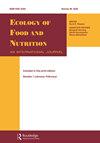Kitchen Adequacy and Child Diet Quality in a Racially/Ethnically Diverse Sample.
IF 1.7
4区 医学
Q4 NUTRITION & DIETETICS
Ecology of Food and Nutrition
Pub Date : 2022-01-01
Epub Date: 2021-08-19
DOI:10.1080/03670244.2021.1968848
引用次数: 0
Abstract
This study examined kitchen adequacy in a racially/ethnically diverse low-income sample and associations with child diet quality. Families with children age five to seven years old (n = 150) from non-Hispanic white, non-Hispanic Black, Hispanic, Native American, Hmong, and Somali families were recruited through primary care clinics. More than 85% of families had 15 of the 20 kitchen items queried, indicating that the sample had adequate kitchen facilities. Only one item (a kitchen table) was associated with higher overall diet quality of children. In contrast, children living in households with can openers and measuring spoons consumed more sodium and added sugars, respectively.

不同种族/族裔样本中的厨房充足性和儿童饮食质量。
本研究调查了不同种族/族裔低收入样本的厨房充足性以及与儿童饮食质量的关系。研究人员通过初级保健诊所招募了有 5 至 7 岁儿童的家庭(n = 150),这些家庭分别来自非西班牙裔白人、非西班牙裔黑人、西班牙裔、美国原住民、苗族和索马里家庭。超过 85% 的家庭拥有 20 项厨房调查项目中的 15 项,这表明样本家庭拥有足够的厨房设施。只有一项(餐桌)与儿童整体饮食质量较高有关。相比之下,拥有开罐器和量匙的家庭中的儿童分别摄入了更多的钠和添加糖。
本文章由计算机程序翻译,如有差异,请以英文原文为准。
求助全文
约1分钟内获得全文
求助全文
来源期刊
CiteScore
3.50
自引率
0.00%
发文量
23
审稿时长
>12 weeks
期刊介绍:
Ecology of Food and Nutrition is an international journal of food and nutrition in the broadest sense. The journal publishes peer-reviewed articles on all aspects of food and nutrition -- ecological, biological, and cultural. Ecology of Food and Nutrition strives to become a forum for disseminating scholarly information on the holistic and cross-cultural dimensions of the study of food and nutrition. It emphasizes foods and food systems not only in terms of their utilization to satisfy human nutritional needs and health, but also to promote and contest social and cultural identity. The content scope is thus wide -- articles may focus on the relationship between food and nutrition, food taboos and preferences, ecology and political economy of food, the evolution of human nutrition, changes in food habits, food technology and marketing, food and identity, and food sustainability. Additionally, articles focusing on the application of theories and methods to address contemporary food and nutrition problems are encouraged. Questions of the relationship between food/nutrition and culture are as germane to the journal as analyses of the interactions among nutrition and environment, infection and human health.

 求助内容:
求助内容: 应助结果提醒方式:
应助结果提醒方式:


